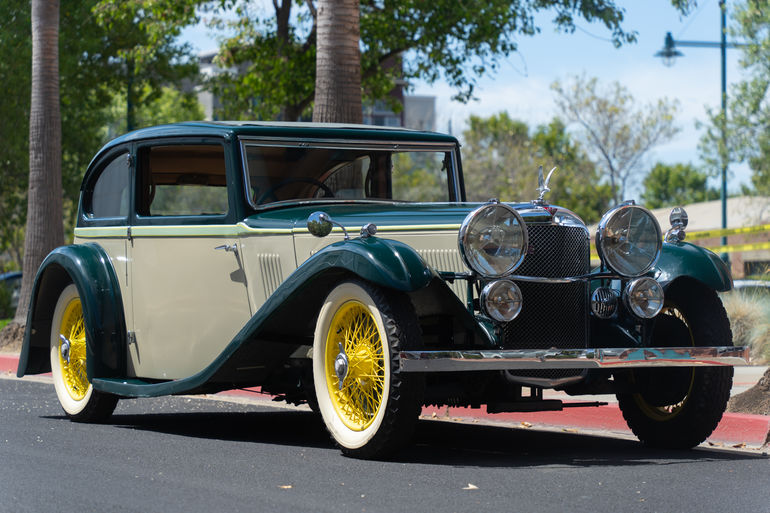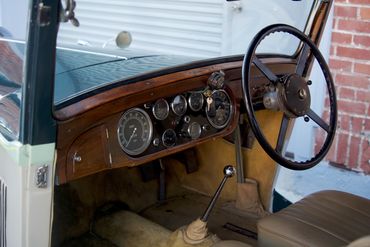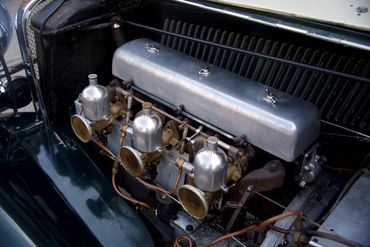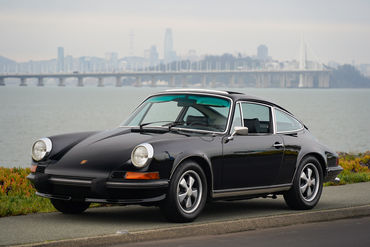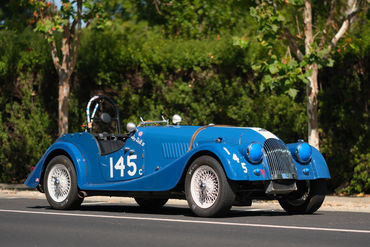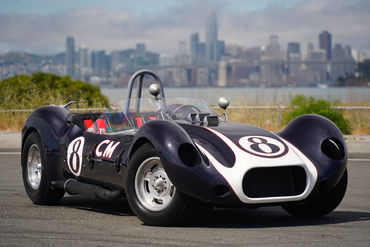Sold
SOLD 08/22
1934 Alvis
Speed 20 Sports Saloon by Vanden Plas
Bring a Trailer NO RESERVE auction preview: 1 of 8 Vanden Plas bodied Speed 20 Sport Saloons in existence. Long term California Ownership with extensive early documented history. Ideal four-place touring car with 2.5 liter engine and synchromesh transmission.
- VIN11619L98
- Exterior ColorGreen with Yellow accents
- Interior ColorTan leather
- Mileage45537 Miles (TMU)
- Engine2.5 litre inline-6
- Engine no.11615 19•8
- Transmission4-speed manual
- StatusSold
- StockFJ2631
Description
1934 Alvis Speed 20 Sports Saloon
VIN – 11619L98
Engine No. – 11615198
Exterior Color – Green with Yellow accents
Interior Color – Tan leather
Engine – 2.5 Liter inline 6-cylinder
Transmission – 4-speed manual
Highlights of this Car
-One of Eight Vanden Plas bodied Speed 20 Sport Saloons in existence
-Long term California Ownership with extensive early documented history
-Ideal four-place touring car with 2.5 liter engine and synchromesh transmission
General Overview
Among the earliest British constructors that developed sporting saloon designs, Alvis rapidly distinguished themselves as recognized leaders in this growing area of sporty luxury coupes and roadsters. Founded in 1919, Alvis built a wide range of cars including military vehicles, aircraft engines, and race cars. As interest grew in their road cars, competition from other manufacturers pushed Alvis to develop more powerful cars catering to the luxury market. By 1927, the advent of their own six-cylinder engine ushered in a new era for Alvis with elegant designs evolving by 1934 featuring independent front suspension, synchromesh gearbox, servo-assisted brakes, and improved handling, all of which made the Alvis a marketplace leader not just in the UK, but throughout the world.
Like many manufacturers of this period, Alvis supplied their chassis to coachbuilders who produced bodies in a range of materials, often custom ordered by specific clients seeking the very best in performance and design. Built from 1931-1934, the Speed 20 was configured for several model styles but the two door Sports Saloon with Vanden Plas coachwork is considered a rare and desirable configuration and certainly among the most beautiful created by a renown coachbuilder. Built upon the low-slung double-dropped chassis and combined with the 2511cc OHV inline six-cylinder engine, the potent and capable Speed 20 was referred to as a sports car by 1934, and rightly so – it had the performance and driving manners to support such claims. With independent front suspension, specially designed Alvis shock absorbers, and an all-synchromesh transmission (a first for a British car, on license from General Motors). The new models offered performance, comfort, and ease of use, features that were rarely so well combined in both a sporty and luxurious motorcar.
History of This Car
As indicated in the Alvis Car Record accompanying this car, the “remarks” section offers one of the most enticing pieces of information on the history of this car – “Delivery to C. Follett, London”. Charles Follett earned his reputation in the London motor trade as the premiere source for pre-owned cars of exotic distinction. As such, his clientele often sought him out for unique cars. Follett enjoyed traveling throughout Europe to purchase cars for his elite customers. In 1931 he approached Alvis to become an exclusive Alvis concessionaire for the city of London. Follett immediately began advertising and promoting Alvis to the lofty motorcar status consistent with Invicta and Bentley, complete with lavish showrooms and white glove treatment. Aware of the somewhat conservative nature of Alvis cars, and the need for a fresh series of designs for his clients, he proposed to Alvis that they allow a substantial reduction in chassis cost to him, providing he would commit to a minimum order of 100 units, nearly all of which would be dispatched to Vanden Plas for either Saloon, Tourer, or Drophead Coupe, reflective of designs Follett had approved. Of the Vanden Plas series cars built, 36 examples of the Speed 20 SB “Flatback” were completed, a mere eight of which are known to exist today. Often finished in two tone paint, the four-passenger configuration, louvered hood, rakish style, flowing fenders, and outside filler cap create an elegant and sporting impression, surely among the very best of the Alvis marque and one of the finest closed coupe designs of the period.
This Alvis Speed 20 SB “Flatback” has been referenced for many years in registries and documentation as AKR 249, reflective of the only license plate assigned to the car. Reportedly serving as the Alvis London Motor Show car, the first owner is believed to have been the distinguished Lord Lieutenant of Kent. Lord Harris, the 4th Baron Harris. A storied British Colonel and Governor of Bombay, His Lordship was an amateur cricketeer and servant to Conservative Government as Lord in Waiting to Queen Victoria. According to Wayne Brooks, North American Representative for the Alvis Owner Club, the second owner, J.W.R. Wright, also of Kent, purchased the car and retained it for many years, subsequently selling it in 1961 to the third owner, Paul Wraith, also of Kent. In a lengthy handwritten 1997 letter penned by Wraith, he references the purchase in detail, including Wright’s assertion that the car had been the London Motor Show car. After his purchase, noted in July 1961, Wraith spent the next two years preparing it to be serviceable, though unintentionally effectively restoring the car. In-between his time as a nuclear engineer Wraith managed to rebuild both the engine and transmission, service the suspension, freshen various features and components, and return the onboard jacking system to operation. His wife, however, was unable to drive it. As such, the arrival of a new baby determined the sale to local UK buyers.
By 1967, the car was imported to the US, arriving in Temple, TX, and a sale arranged to Bruce Earlin, Milford, PA either through a UK dealer or via US serviceman. Earlin reportedly drove the car to his home in Milford and then sold the car to Roger Langston, Baltimore, PA. Langston sold it back to Earlin during domestic reorganization, and Earlin then sold the car to Robert Heyn, Sacramento, CA who subsequently sold the car to Tom Strup, also of Sacramento. In 1985, Strup sold the car to Barbara and Kent Walker who have lovingly cared for AKR 249, enjoying all aspects of their ownership while continuing to research and preserve the history of this rare car. Important documents supporting the history and build of this car include a copy of the Alvis “Car Record” which bears the car number as shown on the chassis tag and the engine number which also corresponds to the stampings on the engine. The section “Body Particulars” indicates “chassis only” which is typical of cars that were sent out coachbuilders, noted with delivery to the previously mentioned London-based entrepreneur and Alvis concessionaire Charles Follett.
Condition Overview
Today this Alvis presents as an impressive example of pre-war sport motoring. The elegant and sporty Vanden Plas saloon coachwork is among the finest execution of the period, consistent with any Bentley one might find from the same era, yet with a lightness and delicate level of refinement seldom seen in larger cars. Workmanship throughout is impressive and properly conceived with ample evidence of high-quality craftsmanship throughout. Although the older restoration has mellowed over time, the elegant, low-slung alloy body exhibits a poised performance stance with its impressive louvered hood, elegantly descending front fenders, and beautifully arched rear roofline. The rear of the car is very British with minimal overhang and a single spare tire mounted to the razorback (often referred to as flatback) rear panel, concealing the hidden boot. The beautifully curved rear fenders fit tightly to the tires, which feature knock-off mounted wire wheels finished in yellow, a color favored by the wife of the current owner. The green and taupe finish is glossy throughout, exhibiting very good coverage and smooth reflections, though showing signs of age in typical areas, attributed to the years that have lapsed since the restoration was performed. The condition, design, and exterior details are all evidence of clever construction, reflective of period-correct cars of this sporty and luxurious nature. The Vanden Plas bodywork offers a classic profile with desirable proportions delivering a very impressive front view featuring large headlamps, fog lamps, and a proud Alvis hood ornament terminating the long hood lines.
The interior continues the sporting themes with an array of original type instruments filling the varnished wood dashboard and accented by a commanding black steering wheel. Of particular note, the seating position allows ample room for tall or longer legged drivers and excellent visibility over the hood, a feature rarely found in closed cars of this era. The pleated leather seats have a nice feel to them, gently relaxed since the restoration was completed, giving the seating surfaces a purposeful quality which is quite fitting considering the sporty bucket seat design and floor mounted shifter. The overall look and feel are very authentic, as time has gracefully allowed for this stately presence. As with so many pre-war coachbuilt cars, the beauty lies in the combination of functional beauty and the artistry of the vehicle. The backseat offers ample room for adults, the wood and leather accents greatly enhance the interior, and the cabin feel is spacious owing to generous glass area.
Under the hood, mechanical artistry blends with the simplicity of the era. The impressive original in-line six-cylinder engine, stamped with the engine number that corresponds to the build records, conveys an authentic feel, faithful preservation, and proper maintenance. The overhead valve engine design is a key feature to these cars, indicated by the polished cover, polished SU carburetors, and an efficient induction coupled with a dual ignition system. As originally designed, the car runs on a 12-volt battery and electrical system. The various mechanical components are consistent with Alvis production, much of which appear to be original with only a few upgrades for modern use. The underside of the car is consistent with the presentation, clean and tidy with no evidence of structural compromise to the frame or major suspension components. This car is currently titled on a clean California title using a version of the engine number as the VIN.
Although this Alvis is complete and running, the restoration was performed many years ago and as such it should be considered a candidate for mechanical restoration. Having driven the car approximately 2 miles, the engine starts, idles, and runs, however the water temperature increased in that short time, indicating the need for a cooling system overhaul.
Considered one of the most elegant and sporty Saloon designs of this period, the Alvis Speed 20 with Vanden Plas coachwork is one of eight examples known to exist today. Rarely seen in such complete condition, retaining the matching engine and boasting known history since new, this Speed 20 is an excellent candidate for enjoyable use as is or as the deserving subject of a future restoration.
This Alvis Speed 20 comes with an assortment of small parts, a hand crank, small hand tools, spare pieces of leather, and copies of notes on the car, a copy of the Alvis build sheet, and reference information on the history of the car.
The above vehicle information is complete and accurate to the best of our knowledge at the time it is posted to this website. Corrections or additional information is always appreciated. All advertised prices exclude government fees and taxes, any finance charges, any dealer document preparation charge, and any emission testing charge. Vehicles are subject to prior sale. All advertised to be true but not guaranteed. We assume no liability for errors or omissions.
Inquire About This Car
Fantasy Junction • 510-653-7555 • 1145 Park Ave, Emeryville, CA 94608
